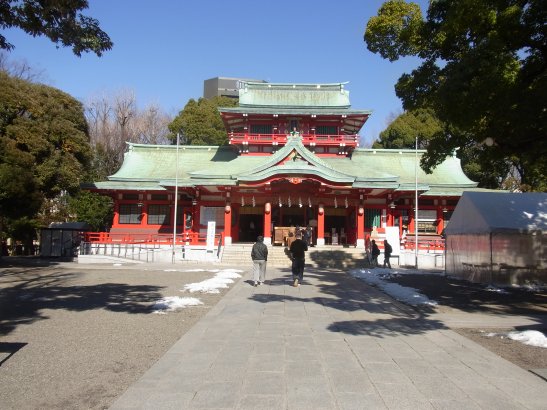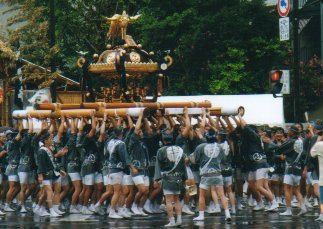 富岡八幡宮
富岡八幡宮「神社」は日本の古代の宗教である「神道」の「神々」に捧げられたものです。
“Jinja 神社 Shrines” are dedicated to “Kami-gami 神々 Deities” of the “Shinto 神道”, Japan’s ancient
religion.
“Jinja
Shrines” can be found throughout Japan.
It's said that Japan has around 80,000
“Jinja Shrines”.
People
visit “Jinja Shrines” on important occasions to make wishes and to offer
thanks.
「神社」はそれぞれの地域で異なった形態があり、異なった「神」の本拠地になっています。
“Jinja
Shrines” take various forms in different locations, and they are home of many
different “Kami 神 Deities”.
People
choose the “Jinja Shrine” that match their needs and pray to specific “Kami Deity”.
Once you pass
under “Torii 鳥居 Gate”, you are in a sacred realm.
The
center of “Sandō 参道Approaches” to “Jinja Shrin” is used by “Kami
Deities”.
So it’s
considered proper etiquette for visitors to avoid walking in the center of
“Sandō 参道Approaches”.
As you
proceed, you will come to “Chōzu(Temizu)-ya(sha) 手水舎 Purification basin”.
Before
presenting yourself to “Kami Deity”, you're supposed to cleanse your hands and
mouth to get rid of impurities.
“Haiden 拝殿 Hall of worship” is where you offer prayers to “Kami Deity”.
Ringing
the bell is said to summon “Kami Deity” and to restore your innocence.
The most common way to worship is to bow
twice and then clap twice.
Then you pray in silence, and you bow one
more time at the end.
“Jinja
Shrines” is a place where you can offer up a prayer and purify your body and
soul, so that you can get on with your daily life feeling refreshed and
renewed.
Japan has a natural belief that “Kami-gami
Deities” dwell in nature such as mountains, rivers, trees and rocks.
There
are rocks and large trees where the “Kami Deity” dwells all over Japan.
Eventually,
the roots of “Jinja Shrine” began to create a temporary altar and perform
rituals.
When
Buddhism was introduced in the 6th century, Buddhist statues and temple
building techniques were introduced to Japan.
It is
said that “Jinja Shrines” were built under this influence.
In
Japan, crop harvesting has been thought to come from the “Kami God” that controls
nature such as the sun and rain.
For this reason, many “Matsuri 祭りFestivals” have been held at “Jinja Shrines” to wish for and
appreciate the “Gokoku-hōjō 五穀豊穣 Rich harvest”.
 富岡八幡宮
富岡八幡宮
「祭り」の見どころは「神(御)輿」の「巡行(渡御)」です。
The highlight
of “Matsuri 祭りFestivals” is “Junkō (Togyo) 巡行(渡御) Parade” of “Mikoshi
神輿 Portable shrine” or “Mikoshi Palade”.
In
ancient times, “Tennō 天皇 Emperors” and “Kizoku 貴族 Aristocrats” would ride in “Kago 駕籠 Palanquins” called “Koshi 輿.
“Mikoshi
Portable shrine” is the vehicle for “Kami-gami 神々 the Deities” of Japan.
“Mikoshi
Portable shrines” is a highly ornate miniature replica of “Jinja 神社 Shrine”.
By the
tenth century “Junkō (Togyo) Parade” had become common practice in Kyoto to
placate the malevolent spirits believed to cause epidemics.
“Kami Deity”
usually stay at “Honden 本殿 Main hall” that is
shut away deep inside “Jinja 神社 Shrine.
At start
of “Matsuri Festival”, “Kami Deity” transfer from “Honden Main hall” to “Mikoshi
Portable shrine”.
And “Mikoshi
Portable shrine” is brought out from “Keidai 境内 Precinct” with local people and parade through the area where “Kami
Deity” protects.
“Mikoshi
Parade” is a rare chance for the local people to get close to “Kami Deity”.
This
practice gradually spread throughout the country.
And it changed into various types of “Mikoshi
Palade” in each region.
The roof-tops
of most “Mikoshi Portable shrines” are decorated with “Hō-ō 鳳凰 Phoenix”.
“Hō-ō Phoenix”
is believed to be highly “Kicchō 吉兆 Auspicious”.
According
to “Densetsu 伝説 Legend”, the appearance of “Hō-ō Phoenix”
heralds the birth of a great ruler.
The
original “Mikoshi Portable shrine” was a tall “Dashi 山車 Float” with wheels.
Since
the middle of “Meiji-jidai 明治時代Poriod”, electric
wires and telephone lines have been installed around the streets in Tokyo and
other cities.
Therefore,
instead of pulling “Dashi Floats”, people hump “Mikoshi Portable shrines”.
“Mikoshi
Portable shrines” are lively carried through city wards on the shoulders of
twenty or thirty people dressed in special “Matsuri Festival” clothing.
担ぎ手たちは、一体的な動きをするために「ソイヤ、ソイヤ!」、「セイヤ、セイヤ!」、「ワッショイ、ワッショイ!」などと声を発します。
The
carriers shout “Soiya, Soiya!” “Seiya, Seiya!”, “Oisa, Oisa”or “Wasshoi,
Wasshoi!” as they move in unison.
As “Mikoshi
Portable shrine” is tossed or shaken, it appears that “Hō-ō Phoenix” on top
flaps its wings and flies.
This movement is believed to stimulate “Kami
Deity” inside, heightening its power of spirits.
